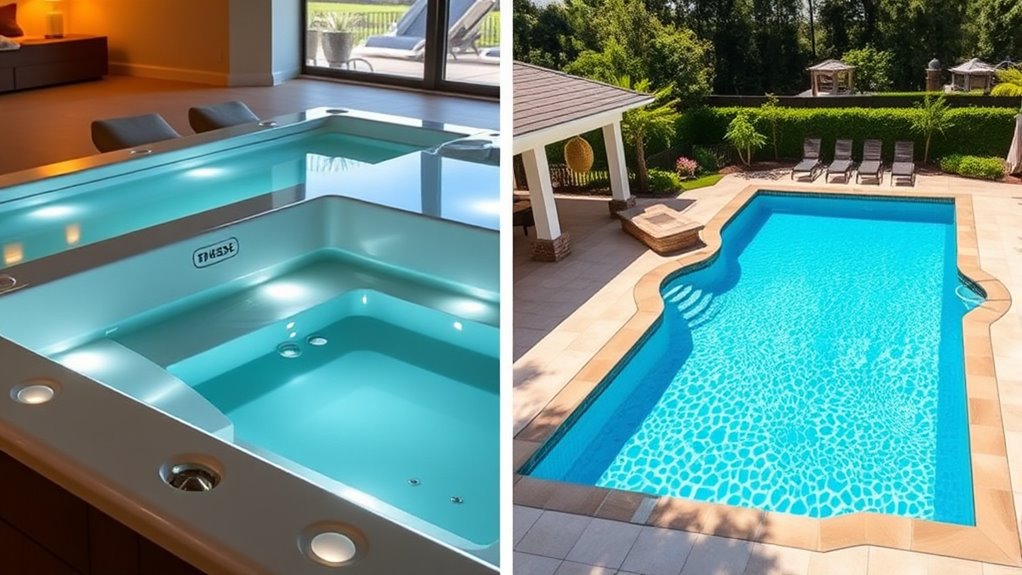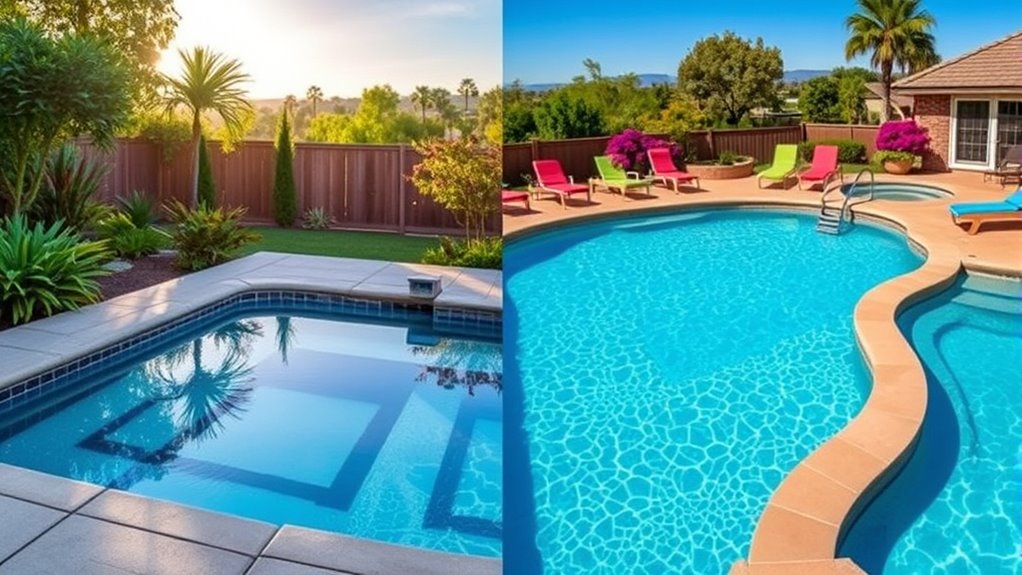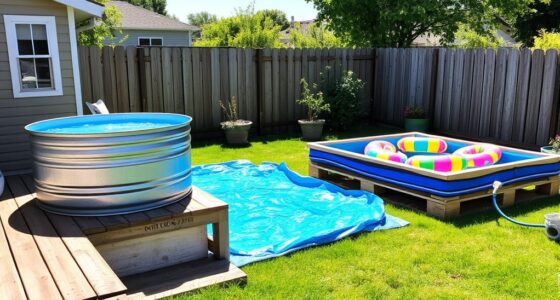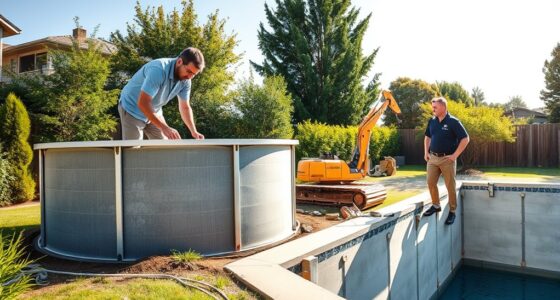Compared to a traditional pool, a swim spa is usually more cost-effective over time because of its lower installation, energy, and maintenance costs. Swim spas are smaller, easier to install, and feature energy-saving technology that keeps running expenses down. They also need less water, fewer chemicals, and simpler cleaning routines. While initial prices may be similar, the long-term savings make swim spas a budget-friendly choice—discover more about how they can benefit you.
Key Takeaways
- Swim spas generally have lower upfront costs and installation expenses due to smaller size and easier setup.
- They are more energy-efficient, leading to significantly lower ongoing electricity bills compared to traditional pools.
- Maintenance costs for swim spas are typically lower, thanks to smaller water volume and integrated self-cleaning features.
- Long-term expenses favor swim spas, with reduced repair needs and fewer chemical and equipment costs over time.
- Overall, swim spas offer a more affordable solution considering initial investment, energy, and maintenance over the lifespan.

When deciding between a swim spa and a traditional pool, understanding the costs involved is vital. One of the key factors worth examining is energy efficiency. Swim spas are generally more energy-efficient because they are smaller than standard pools and often come with advanced insulation and energy-saving features. This means your electricity bills are likely to be lower over time. Traditional pools, on the other hand, require more water, bigger pumps, and larger filtration systems, all of which consume more energy. If you’re looking to minimize ongoing expenses, a swim spa’s energy-efficient design can be a notable advantage.
Swim spas are more energy-efficient, leading to lower ongoing electricity costs.
Maintenance costs also play an important role in your decision. Swim spas typically have fewer maintenance requirements compared to large pools. Their smaller size means fewer chemicals are needed to keep the water balanced, and their filtration systems are easier to clean and replace. Additionally, because swim spas often come with self-cleaning features or integrated filtration systems, you spend less time and money on upkeep. In contrast, traditional pools require regular cleaning, chemical balancing, and equipment maintenance that can add up quickly. Larger pools tend to accumulate debris more easily, and their extensive plumbing and filtration systems can be costly to repair if something goes wrong.
When considering installation costs, swim spas usually cost less upfront than installing a traditional pool. They are often modular, making them easier and quicker to set up, especially if you opt for a portable or semi-permanent model. With pools, excavation, landscaping, and extensive plumbing can substantially increase initial expenses. This means that even if the purchase price of a swim spa is comparable or slightly higher, the overall investment often ends up being lower once installation and ongoing costs are factored in. Additionally, the ease of installation of swim spas can reduce labor costs and installation time significantly.
Another point to keep in mind is how these features translate into your long-term budget. Because swim spas are smaller and designed for efficiency, you’re likely to see lower energy bills and fewer repair costs over the years. Traditional pools, while providing a larger swimming area and possibly more aesthetic appeal, tend to incur higher maintenance and energy expenses, especially as they age. If your goal is to enjoy a pool environment without the hefty recurring costs, a swim spa offers a compelling balance of affordability, convenience, and energy savings.
Frequently Asked Questions
How Long Does a Swim Spa Typically Last?
You might wonder how long a swim spa lasts. Typically, with proper maintenance, its lifespan expectations range from 10 to 20 years. Regular upkeep, like cleaning filters and checking the equipment, can extend its maintenance longevity. Keep in mind that high-quality models tend to last longer, so investing in good materials and professional service helps maximize your swim spa’s durability and enjoyment over the years.
Are There Hidden Costs Associated With Maintaining a Swim Spa?
Like a well-kept secret from the 1800s, hidden expenses can catch you off guard when maintaining a swim spa. You might face maintenance surprises such as filter replacements or increased energy costs. These hidden costs add up over time, so it’s wise to budget for routine upkeep and occasional repairs. Staying proactive helps avoid unexpected expenses and keeps your swim spa running smoothly, saving you money in the long run.
Can a Swim Spa Be Used Year-Round in All Climates?
You can typically use a swim spa year-round in most climates, thanks to its climate adaptability features. With proper insulation and a reliable cover, it maintains warmth during seasonal changes, allowing for consistent seasonal usage. However, in extremely cold regions, you may need additional heating options or cover insulation to guarantee comfortable use. Overall, swim spas are designed for year-round enjoyment, regardless of seasonal weather variations.
What Are the Energy Efficiency Differences Between the Two?
When comparing energy efficiency, you’ll notice that swim spas generally consume less energy than pools because they’re smaller and better insulated. Their insulation efficiency helps retain heat, reducing energy consumption for heating. Pools require more energy to maintain water temperature and circulate large volumes of water. So, if you’re looking to save on energy bills, a swim spa’s design makes it a more efficient choice overall.
How Does Installation Complexity Compare Between Swim Spas and Pools?
Did you know installing a swim spa can take 50% longer than a traditional pool? You face more installation challenges and site preparation, especially due to its compact size and integrated systems. With a swim spa, you often need specialized equipment and adjustments to your space. Pool installation, while still complex, generally involves fewer challenges and less site prep, making it quicker and easier to enjoy your backyard.
Conclusion
In the end, choosing between a swim spa and a pool is like picking between a trusty old car and a shiny new sports car — both get you where you want to go, but the costs and upkeep differ. A swim spa might be your budget-friendly companion, offering year-round convenience, while a pool can be a backyard splendor. Whichever you choose, make sure it fits your dreams and wallet, so your backyard stays a haven, not a financial headache.









